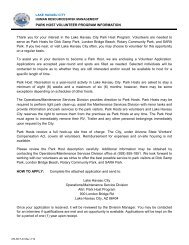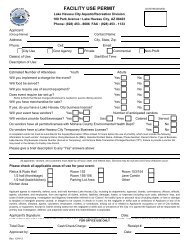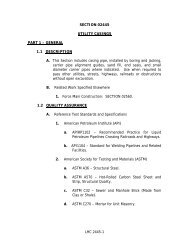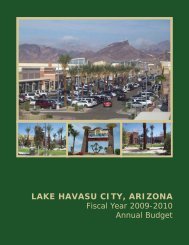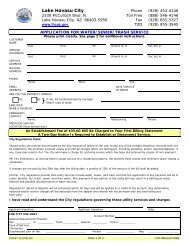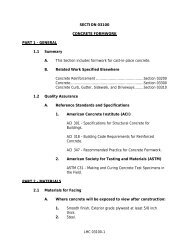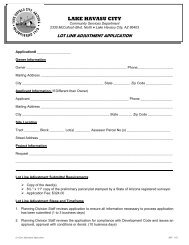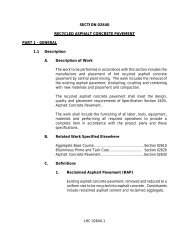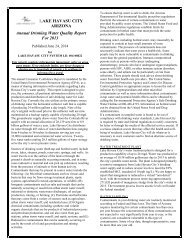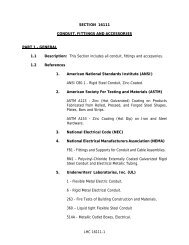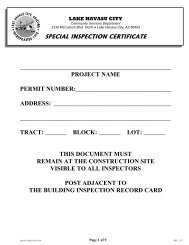2008 Water Rate and Fee Study - Lake Havasu City
2008 Water Rate and Fee Study - Lake Havasu City
2008 Water Rate and Fee Study - Lake Havasu City
Create successful ePaper yourself
Turn your PDF publications into a flip-book with our unique Google optimized e-Paper software.
Section 5Cost-of-Service<strong>City</strong>’s water system. This indicates that 62 percent of the capacity of facilities designed<strong>and</strong> operated for maximum day dem<strong>and</strong> is needed for average or base use. Accordingly,the remaining 38 percent is for maximum day extra capacity requirements.Since maximum hour water usage also utilizes facilities designed <strong>and</strong> operated foraverage day <strong>and</strong> maximum day dem<strong>and</strong>s, the costs associated with meeting maximumhour dem<strong>and</strong>s are allocated to base, maximum day extra capacity, <strong>and</strong> maximum hourextra capacity. Based on the system design criteria, a ratio of maximum hour to annualaverage day water use of 2.50 is assumed. This ratio indicates that approximately 40percent of the capacity of facilities designed <strong>and</strong> operated for maximum hour dem<strong>and</strong> isneeded for average or base use, 24 percent is required to meet maximum day extracapacity dem<strong>and</strong>, <strong>and</strong> the remaining 36 percent is for maximum hour extra capacitydem<strong>and</strong>.5.2.3. Allocation to Functional Cost ComponentsVarious functions are involved in providing safe, on dem<strong>and</strong> potable water to customers.Functional costs apply to both operating <strong>and</strong> capital costs. The <strong>City</strong> tracks <strong>and</strong> distributesoperating costs to the following functions:• Treatment• Distribution• Production• Meters & Services• Administration• <strong>Water</strong> Overhead• Direct RevenueRed Oak grouped existing assets into similar functions for the cost-of-service analysis.Once operating <strong>and</strong> capital facilities are organized by function, the functional costs areallocated among service dem<strong>and</strong> categories based on the service provided (e.g., treatmentfacilities <strong>and</strong> costs are sized based to provide treated water under maximum dayconditions) <strong>and</strong> summarized in pages B - 6 through B – 8.Revenue requirements are generally allocated to the functional cost components <strong>and</strong>these functional costs are then allocated among service categories that reflect the designparameter of the associated facility. For example, treatment facilities are related to thefacilities that provide treated water to the <strong>City</strong>’s customers. These facilities are designedto meet average <strong>and</strong> maximum day dem<strong>and</strong>s. Thus, treatment expenses are allocated tothe base <strong>and</strong> maximum day cost components. In similar manner, production expenses areallocated to base, maximum day, <strong>and</strong> maximum hour cost components based on thedesign parameters related to maximum hour dem<strong>and</strong> requirements.<strong>Lake</strong> <strong>Havasu</strong> <strong>City</strong><strong>2008</strong> <strong>Water</strong> <strong>Rate</strong> <strong>and</strong> <strong>Fee</strong> <strong>Study</strong>49440145-2



